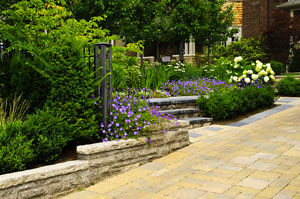
Story: Karen Booth
Photos: Patrick Redmond
If there is such a thing as a quintessentially Australian style of landscape design then this garden would fall into that category. Featuring a relaxed, mainly native planting scheme and a modern lifestyle-oriented layout, the garden sits comfortably in its bushland setting. As a result, the landscape surrounding the architect designed home exudes an authentic sense of place.
Drawing his inspiration from the local environment, landscape designer Jim Fogarty devised a plan that incorporated Australian native plants, many of them indigenous, as well as plants originating from other parts of the world with compatible growing conditions. Having selected plants ‘designed’ to flourish in the local climate, the next step was to achieve the perfect mix of colours, both foliage and flowers.
Making the most of what was a sloping site was central to the success of this project. A set of steps made from sandstone and recycled red gum sleepers leads to the front door, via a random sandstone path and a sandstone-paved front courtyard. This courtyard features a timber dining setting covered by a large umbrella. To one side there is a timber bench where you can sit and admire the view, or if you crave shade, recline in one of the wicker loungers tucked beneath the portico protecting the entrance to the home.
A small causeway separates the home’s master bedroom from the main part of the home. Through this area Jim has constructed a running creek bed, which starts at the back of the house on the higher ground and cascades underneath the causeway into a catchment area right next to the front door.
This water feature may have taken some time to build but it is now the dominant part of the garden, as well as its nucleus. Originally, the clients had thought of this being a spa pool, but changed their mind once the job started. This is the focal point at the front of the house.
An expansive lawn of Kentucky bluegrass (Poa pratensis), a reasonably hardy variety of turf with an upright growth habit, provides a centrepiece to the deep sweeping garden beds. Ornamental grasses have been incorporated throughout the design to bring vitality and colour during the cold Melbourne winter while other plants are dormant.
Massed areas of ornamental grasses, including long-lived, drought-tolerant plants such as fountain grass (Pennisetum alopecuroides), lomandra (Lomandra longifolia) and the fine-leafed blue tussock grass (Poa labillardieri ‘Eskdale’) create interest. Regal clumps of maiden grass (Miscanthus sinensis) punctuate the landscape, swaying in the breeze and adding movement.
Elsewhere in the garden, the rich foliage tones of the shrubby smoke bush, in this instance Cotinus coggygria ‘Grace’ (which produces an abundance of feathery burgundy leaves throughout the year), stand in contrast with the elegant dark grey-green foliage of the blackwood (Acacia melanoxylon), the round-headed drooping sheoak (Allocasuarina verticillata), the snow gum (Eucalyptus pauciflora) and the grafted flowering gums, Eucalyptus ‘Summer Beauty’ and ‘Summer Red’. Specially bred for use in residential gardens, these two eucalypt hybrids have distinctive bronzed leaves and produce masses of flowers in summer: soft pink for ‘Summer Beauty’ and mid-pink to red for ‘Summer Red’.
The pathway running up to the back of the house is designed to be rustic and soft on the eye. Surfaced with crushed granite and limestone, the path contains steps made from Mansfield mud rock. Framing these steps is an interesting combination of dusty miller (Senecio cineraria), a clumping perennial with dense silver-grey leaves, and the bronze-leaded leather leaf sedge (Carex buchananii), which originally hails from New Zealand.
Complementing the look and texture of the crushed stone back garden path, the driveway has been surfaced in exposed aggregate.
This garden gives a sense of enclosure which is very comforting. It is also pleasing to the eye thanks to the significant effort expended to ensure the plant life would flourish and the living areas were designed to suit the relaxed Australian way of life.






